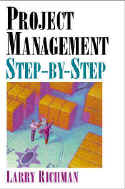Project Management Step-by-Step
Offering clear, concise explanations of different project phases, Project Management Step-by-Step also includes six case studies—positive and negative, real and fictional—that show clearly how project management works in the real world. The book is fully consistent with the newly updated Project Management Body of Knowledge, so its observations and recommendations are consistently applicable and thoroughly field-tested. Richman’s clear, accessible text is augmented with discussion questions, exercises, diagrams, charts, and a comprehensive glossary. Special passwords to free online information for students, instructors, and project management professionals are alone worth the price of the book.
Written in plain, jargon-free English, Project Management Step-by-Step is an incisive and complete guide—truly a perfect introduction to project management.
Why learn project management?
Many people become project managers by accident. They are assigned to lead a project because of their area of expertise—not because they have received any project management training. This concise book shows you how to manage projects step by step.
What can project management do for you?
Project management skills help you complete projects on time, on budget, and on target!
Project Management Step-by-Step shows how to use proven strategies in large or small projects to clarify the objectives, avoid serious errors of omission, and eliminate costly mistakes. It also addresses the people skills needed to get the cooperation, support, and resources to get the job done.
Modern project management has emerged as a premier solution in business and non-profit organizations. Project managers find success using a structured approach to project planning, scheduling, resourcing, decision-making, and control.
Who needs project management?
This book isn’t just for project managers. Team members need to know how carry out their part of the project and business executives need to understand how they must support project management efforts in the organization.
Table of Contents
Unit 1: Preparing for Project Management Success
Chapter 1: Understanding the Importance of Project Management
Chapter 2: Organizing for Project Management Efficiency
Chapter 3: Defining the Roles of the Project Manager
Chapter 4: Defining the Roles of Client, Customer, and Stakeholders
Chapter 5: Setting Up a Planning and Control System
Case Study: CXI Cellular
Unit 2: Planning the Project
Chapter 6: Defining the Project
Chapter 7: Creating a Work Breakdown Structure
Chapter 8: Estimating the Activities
Chapter 9: Sequencing the Activities
Case Study: Geebold Manufacturing
Chapter 10: Analyzing the Critical Path
Chapter 11: Preparing Schedules
Chapter 12: Preparing Resource Plans
Chapter 13: Preparing Budget Plans
Chapter 14: Compiling a Project Charter and Getting Approvals
Chapter 15: Setting Up a Monitoring and Control Process
Case Study: Urgent Care Hospital
Unit 3: Executing theCase Study: Geebold Manufacturing
Chapter 10: Analyzing the Critical Path ntrolling Project Objectives
Chapter 18: Reporting on Project Objectives
Chapter 19: Controlling Project Change
Chapter 20: Conducting Project Evaluations
Chapter 21: Managing Risk
Chapter 22: Closing the Project
Case Study: Western Power
Unit 4: Leading the Project Team
Chapter 23: Developing Project Teams
Chapter 24: Managing Conflict
Chapter 25: Communicating Effectively
Chapter 26: Holding Effective Meetings
Case Study: Global Industries
Chapter 27: Making Team Decisions
Chapter 28: Using Sources of Power Wisely
Chapter 29: Managing Change
Chapter 30: Managing Performance
Case Study: Chip Technologies
Suggested Reading
Suggested Resources
Answers to exercises and case studies
Glossary
Index

This book is published by AMACOM Books (American Management Association), now HarperCollins Publishers.
Retail: US $ 27.95
